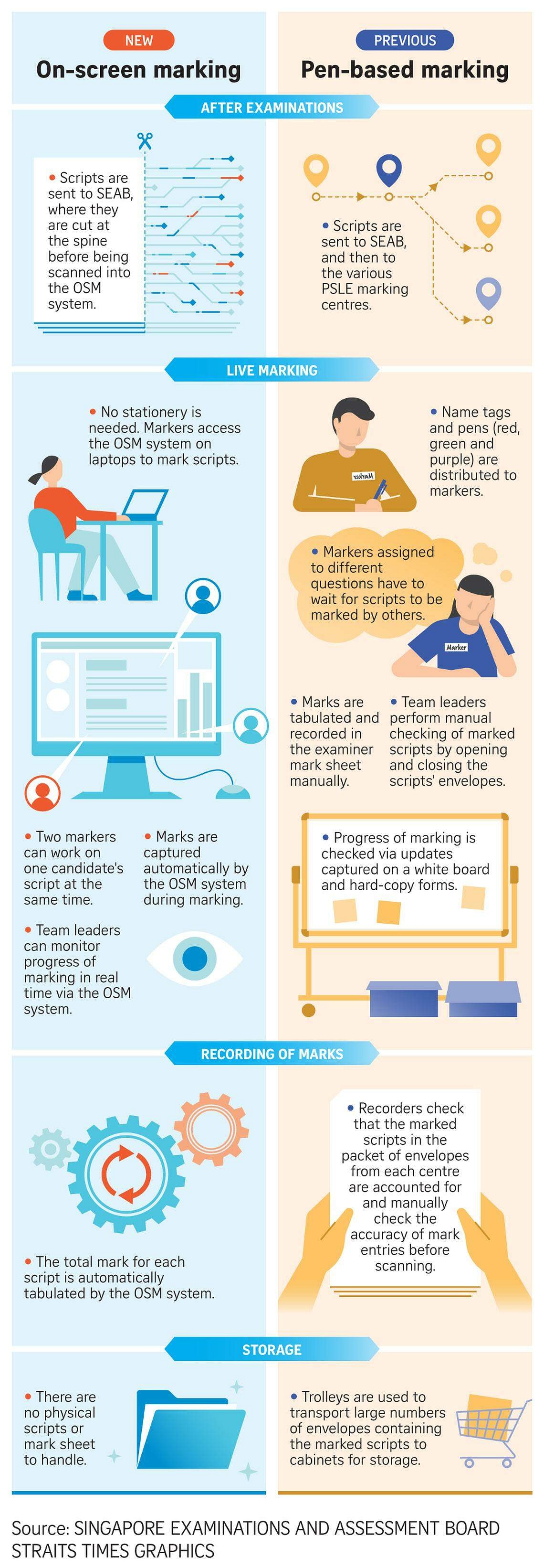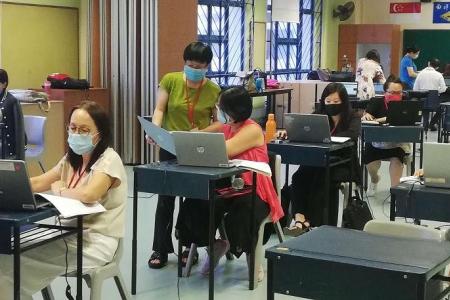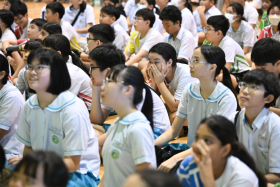PSLE scripts now marked on computer screen
Gone are the days when markers of the annual Primary School Leaving Examination (PSLE) would wield their pens over stacks of exam scripts.
Since the implementation of on-screen marking (OSM) – which involves marking examination scripts digitally on a computer screen – for all PSLE subjects in 2022, the number of teachers deployed for marking duties has been halved from 14,000 to about 7,000 teachers, the authorities said.
In 2023, the number of PSLE marking days was also cut from four days to three days, the Singapore Examinations and Assessment Board (SEAB) told The Straits Times.
Today, the PSLE and locally marked Singapore-Cambridge General Certificate of Education (GCE) examinations are marked online. About 450,000 scripts are marked locally every year. SEAB introduced the OSM system in 2019.
In addition, all GCE examination scripts which are not assessed locally, are marked on-screen by markers appointed by Cambridge International Education in Britain.
Time savings
Educators involved in the PSLE marking told ST that the new OSM system has greatly reduced the time taken to carry out certain marking processes.
Mr Seet Chia Song, 44, who has been marking PSLE scripts for the past 14 years, said that the duration for standardisation – a session that ensures there is a shared understanding of the marking criteria among markers – has been halved with the new system.
“Previously, all the markers had to be assembled in the hall. So the chief marker will brief everyone from the first to the last question. Everyone had to sit through the whole paper,” said the lead teacher for Chinese language at Anderson Primary School.
With the OSM system, markers will practise marking for the set of questions that they are assigned to after the standardisation meeting. So with a quicker standardisation process, markers can begin assessing earlier.
Furthermore, markers do not have to wait for another marker to finish their assigned questions before passing the script to them. Now, two markers can mark different questions on the same paper concurrently, and as such, fewer markers are deployed.
Nonetheless, Mr Seet said he will miss some aspects of the pen-and-paper marking sessions as it was like a reunion with teachers from different schools.
“Right now when I do on-screen marking, it’s just me and my screen. The human-to-human interaction has been reduced,” said Mr Seet.
Mr Chew Mun Wai, 49, who has been a chief marker for the PSLE for the past five years, said the new system is not as labour-intensive.
Mr Chew, who is principal of Xing Hua Primary School, said that with traditional pen-and-paper marking, markers would have to manage all the logistics by handling and accounting for the physical scripts.
There were also many rounds of manual checks to ensure that marks were captured accurately, as markers had to indicate candidates’ grades by manually shading “bubbles” on the mark sheet.
“All this involved a lot of mental energy. We had to make sure that the scripts are always intact, the right number of scripts are in each pack, and then undersign on these things.”
He added that the time freed up from laborious manual processes has resulted in PSLE marking being reduced from four days to three days, and allowed for more time for markers to have professional discussions about how to mark scripts more accurately and consistently.
Mr Terence Woo, 46, who was part of a team involved in designing and implementing the OSM system for use in the national examinations, said the greatest challenge the team faced was not whether it would work but how markers would take to it.
A senior manager of marking and moderation at SEAB, Mr Woo said that markers were initially concerned about how this technology could enhance the marking experience without compromising on quality and the security of the whole examination.
“We were able to allay these concerns through focus group discussions with key marking personnel,” said Mr Woo, adding that the OSM system features created as a result were intuitive and easy to use.
The on-screen marking process
During an examination, candidates will write their answers on answer booklets. When the examination ends, the hardcopy answer scripts are collected and sent to SEAB.
When the scripts arrive at SEAB, the spines of the scripts would be cut by a script-cutting machine, which can cut 1,000 scripts – or 16,000 pages – in an hour with two cutters.
The cut scripts are then fed into the Answer Booklet Scanning System.
This system scans the scripts page by page. Each scanner can scan 140 scripts per hour. Each booklet will have a barcode, QR code and the candidates’ identity sticker. The booklet will also have technical guides that allow the scanner and software application to identify and process the candidates’ papers uniquely.
The OSM system is programmed to automatically check the scanned scripts for errors. This first layer of verification reduces the amount of human work that needs to be done when SEAB staff do a second round of checks.
The candidates’ scripts are then distributed via the OSM system, ready for marking to begin.
Similar to how paper scripts are marked, markers will have to undergo a practice marking exercise so that they are able to mark fairly with a shared understanding of how to assign scores. This is followed by a standardisation test before they are approved to perform live marking.
Correction note: This story has been edited for accuracy.

Get The New Paper on your phone with the free TNP app. Download from the Apple App Store or Google Play Store now


